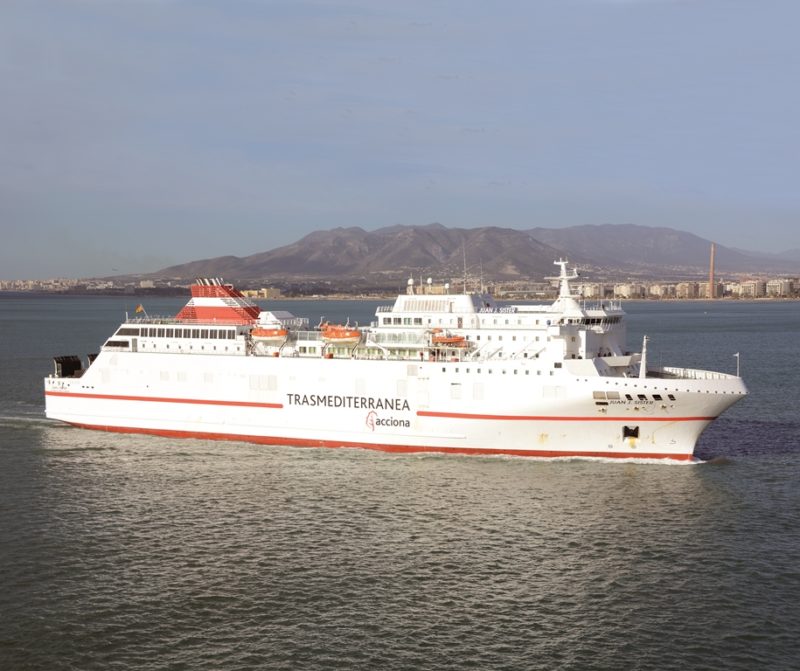
Trasmediterranea of Spain has been serving the islands of Spain for over a century, with three of their fleet that served the Canary Islands actually having the word ‘Sister’ in their names over this long period. This trio of passenger ferries had the names of J. J. Sister built in 1896 as Galileo Galilei and purchased and renamed in 1910, J. J. Sister (2) of 1975, and Juan J. Sister of 1993.
The first J. J. Sister was sold for breaking up at Valencia in June 1964 by Aguilar y Peris, and the second J. J. Sister was sold to Moby Lines of Italy in 1997 and renamed Moby Magic and was sold for breaking up in December 2005 at Aliaga in Turkey, while Juan J. Sister was completed as the flagship of the fleet in 1993 and is still in service for Trasmediterranea. All of this trio were named after Juan Jose Sister, a founder of the Valenciana ferry company that became a constituent member of Trasmediterranea in 1917. Juan Jose Sister had been born in Villanueva del Grao in 1828, and in his youth was a fisherman and later a pilot and shipowner and he died in January 1885.
‘La Tras’ is the colloquial name that Spanish people use for their much loved national ferry line. New Year’s Day of 2017 was the centenary anniversary of the first day that their Spanish national ferry line began to run services to its many destinations including the Balearics, Ceuta and Melilla in North Africa, the Canaries, and the Spanish colonies of Fernando Po and Spanish Guinea in West Africa. Nine small companies came together on that day one hundred years ago, namely Maritima Barcelona, Gijonesa, La Islena Maritima, Menorquina, Navegaceon y Industria, Tintore (founded by Pablo M. Tintore in Barcelona in 1852), Valenciana and Vinuesa fleets.
The actual instrument and deed of the constitution of Compania Trasmediterranea was signed in Barcelona before the Public Notary Antonio Sasot Mejias on 25th November 1916 by Joaquin Maria Tintore of Linea de Vapores Tintore, Enrique Garcia Corrons of Navegaceon y Industria S.A., Jose Juan Domine of Compania Valenciana de Vapores Correos de Africa, and Vicente Ferrer Pesset on behalf of Ferrer Pesset Hermanos companies.
The new company had a large fleet of 44 passenger and cargo ships to call on, mostly small steamers, but the first task was to analyse how these disparate fleets would fit into a national plan. A network of mail, passenger and cargo services was worked out that linked all of the coastal islands and the enclaves of Ceuta and Melilla in Northern Africa, but also the long range services to the seven Canary Islands and the two possessions in the Gulf of Guinea at a great distance from Spain.
1.J. SISTER OF 1896
A fine trio of twin screw, twin masted Italian built sisters, dating from 1896 as Cristoforo Colombo, Galileo Galilei and Marco Polo, were purchased in 1910 for ten million pesetas from Navigazione Generale Italiana (NGI) of Italy and registered in Valencia by La Roda Hermanos and transferred to Valenciana in 1914, and given the names A. Lazaro, J. J. Sister and V. Puchol after the founders of the Valenciana company. They had black funnels with a central white band under NGI, and under Spanish ownership were given black funnels with a central ‘C’ and ‘A’ superimposed in white. They had dimensions of length 281.7 feet, moulded beam of 36.7 feet and depth of 19.8 feet with a loaded draft of 15.0 feet, together with a fo’c’stle of 36.0 feet in length and poop of 46.0 feet in length. They had originally been fitted with twin triple expansion steam engines of cylinder diameter 585, 940 and 1,520 mm with a stroke of 950 mm and taking steam from two boilers, and were twin screw. The trio had been built by the Odero yard at Sestri Ponente near Genoa, and there was actually a fourth sister owned by NGI and registered in Palermo, Ignazio Florio, from the Orlando yard at Livorno, which was sold in 1897 to the Romanian Government and broken up in 1938.
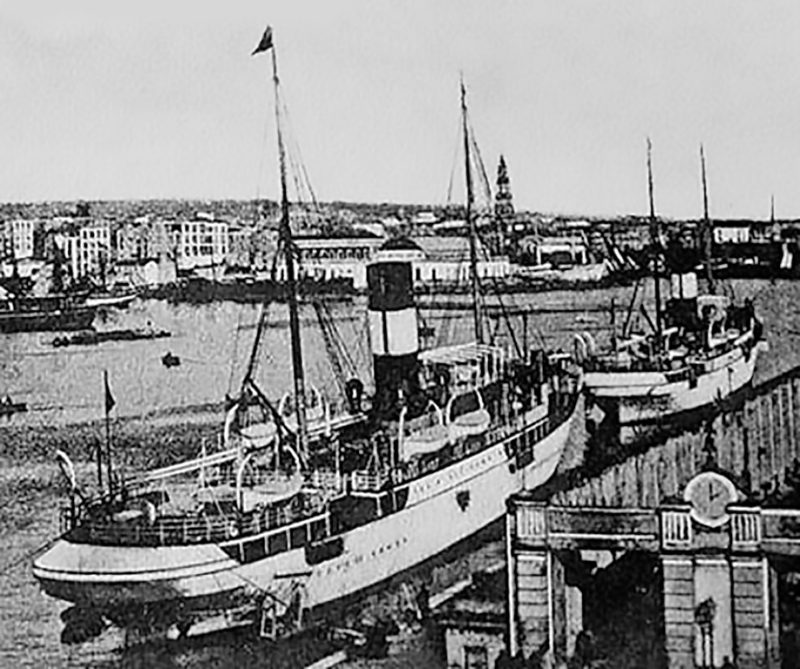
The Promenade Deck of J. J. Sister was equipped with cane easy chairs to port and starboard for sunbathing or taking the air, while her elegant First Class Dining Room had fabric covered carver chairs for diners of small groups at tables, while the Second Class Dining Room had longer tables for diners and smaller chairs. The trio had been frequently used by the Valenciana company from Malaga to Ceuta and Melilla and had accommodation for sixty First Class passengers, some in Second Class, and 350 deck passengers and just over one thousand tonnes of cargo, mostly potatoes.
On one of these voyages, J. J. Sister commanded by Capt. Pedro Tonda, went to the aid of the damaged Italian steamer Adda after receiving distress calls and towed Adda to port after a 15 hour battle in high seas. Capt. Pedro Tonda received a Plaque of Honour, the Merit of the Red Cross, and a Shipwrecked Salvage Medal for his valiant efforts.
The priority was to modernise this elderly fleet, and this was achieved initially by re-engining old ships with ten cylinder M.A.N. diesels manufactured at Augsburg of four stroke single acting design to give a service speed of 12 knots from twin propellers from 1922 onwards, including the important Valenciana trio dating from 1896. J. J. Sister received her twin engines while sitting in the floating dock of the Fijenoord Dockyard at Rotterdam in early April 1924.
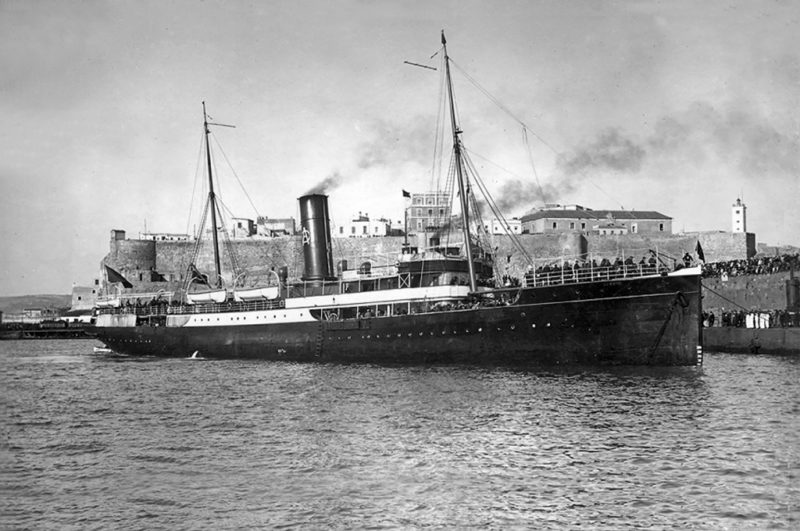
- J. Sister was of 1,527 grt and 734 net tonnage, and had two decks for loading her cargoes of Canarian potatoes and tomatoes on her Trasmediterranea service. The cabins were lit by electric light and her navigation bridge was fitted with Marconi wireless. She was registered at Valencia and her white hull and yellow funnel with a central red band were repainted during refits and special surveys at Valencia. She ran on ten hour voyages from Valencia to Barcelona in winter on Wednesday and Saturday, returning from Barcelona on Mondays and Thursdays, and with an increased service in summer of Tuesdays, Thursdays and Saturdays from Valencia returning on Mondays, Wednesdays and Fridays from the Atarazanas quay near the tall column of Christoforo Columbus in Barcelona.
On 24th April 1924, J. J. Sister, now with new diesel engines, replaced the steamer Mallorca while she was under repair on the Barcelona to Palma de Mallorca route. On 6th June 1924, she sailed from Valencia with a large number of guests onboard to receive the Italian ship Dante Aligieri at sea with the King of Italy onboard before he arrived in Valencia. Later that month, she made her first voyage to the Canary Islands from Seville and Cadiz, and arrived on 15th June 1924 for the first time in the grand harbour of Santa Cruz de Tenerife before moving on to Las Palmas de Gran Canaria and Santa Cruz de la Palma, the ‘green’ island of the archipelago.
On 2nd June 1927, J. J. Sister sailed from Valencia to Sagunto with the entourage of King Alfonso XIII onboard on the occasion of the inauguration of the Monument to the Restoration. On 1st September 1929, she made a recreational cruise from Barcelona to San Feliu de Guixois and S’ Agaro with 402 cruise passengers arranged by Viages Blaus. On 15th October 1929, she had numerous guests onboard on the occasion of the naval manoeuvres of the Spanish Squadron in the Gulf of Valencia, and witnessed by King Alfonso XIII, Prime Minister Miguel Primo de Rivera, the Minister for the Navy and his staff onboard the larger motorship Infanta Cristina, renamed Ciudad de Cadiz in 1931. She then returned to the Valencia to Barcelona route until the new motorships Ciudad de Alicante and Ciudad de Valencia of 2,434 grt were delivered in 1930 for this route, and she then transferred to the Malaga to Melilla route.
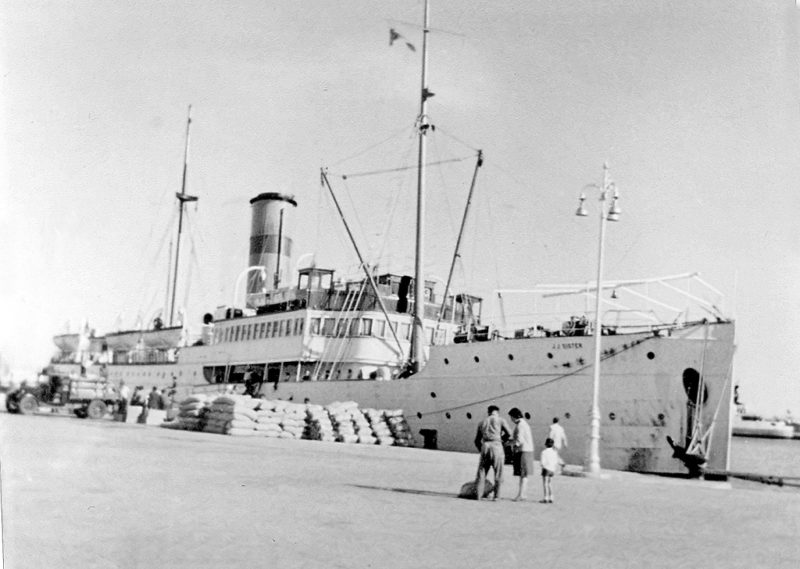
SPANISH CIVIL WAR
On 17th July 1936, simultaneous uprisings occurred across Spain led by General Francisco Franco, who was Commander of the Spanish Army in the Canary Islands and who flew north to take charge of the Spanish Foreign Legion in Morocco, and by General Emiliano Mola on mainland Spain. The Spanish Government was panicked into inaction, and worker militias took charge of many towns, but a large part of the Spanish Army remained loyal to the Republican side of the conflict. The Nationalist side, under General Francisco Franco, had the advantage of German transport planes to fly their Moroccan forces into Southern Andalucia, and then waged a slow, three year war against the Republicans in a clockwise war taking Eastern Andalucia, Extremadura, Northern Spain including the Basque country, Barcelona and Catalonia, Valencia, and then marched into the capital of Madrid through its shattered university district in March 1939 to end the war.
- J. Sister served the Republican side of this brutal conflict as a prison ship moored in the port of Malaga from 18th July 1936 for a year with a large number of imprisoned Nationalist naval officers from Cartagena.
On 20th January 1937, she was missed by a torpedo from a Nationalist submarine, and then on 17th September 1937 in company with Jaime III of Trasmediterranea and guarded by three destroyers en-route to Mahon on Menorca, under the Republican side, she was captured by the Nationalist cruiser Canarias. The destroyers fled and the two liners were ordered into Palma de Mallorca, under the Nationalist side, where their cargoes of food were unloaded. She then sailed to Cadiz, Seville and Santa Cruz de Tenerife, where she arrived on 22nd October 1937 to load troops for Ceuta. She loaded ammunition in January 1938 at Cadiz and participated in the blocking forces against the Nationalists in Sicilian waters.
She was in Barcelona in February 1939 with other ships ready to transport Republican troops of the Army Corps de Maestrazgo to Port de la Selma, but this was not needed. She then sailed with her consorts A. Lazaro, V. Puchol, Rey Jaime II and Mallorca to land troops in the Citadel of Mahon on Menorca and occupied the island before Menorca unexpectedly surrendered. She embarked one thousand troops at Castellon on 6th March 1939 bound for Cartagena followed by other ships before the news broke that Castellon had surrendered to the Nationalists, during which J. J. Sister had to avoid shells from shore batteries.
The war was over on 1st April 1939 with J. J. Sister in Palma de Mallorca and a few days later she sailed for Cartagena to take the Naval Chief of Staff, Admiral Juan Cervera Valderrama, to Seville. She had an anti-aircraft gun placed on the deck of her stern near her aft steering position during the war.
The Trasmediterranea fleet had been almost split down in the middle to participate on the Republican or Nationalist sides of this three year conflict, in which hundreds of thousands died, sometimes with one brother of a family taking the Republican side and another brother taking the Nationalist side and both dying for their cause. Italian troops arrived on the Spanish mainland to help Franco and the Nationalists, while the Republican side was helped by Russian arms and supplies sent by sea to the Spanish eastern Mediterranean coast. The International Brigade was formed with largely British and European volunteers to fight for the Republican side in the bloody battles against the Nationalists.
The Trasmediterranea ships that took the Republican side included the liner Fernando Po, sunk in October 1936 off Bata in Spanish Guinea by the Nationalist auxiliary cruiser Ciudad de Mahon. Ciudad de Sevilla, her sister, was bombed and sunk at Barcelona in January 1939 but was raised, repaired and re-commissioned and continued in service until broken up in 1966. Two more sisters of this quartet of liners, Domine and Villa de Madrid, served as Nationalist and Republican Auxiliary Merchant Cruisers, with Villa de Madrid sunk by Nationalist air attack at Barcelona in January 1939, but was refloated and repaired. Aragon was stopped by a German pocket battleship in the Straits of Gibraltar while operating on behalf of the Nationalists and was handed over to them. Delfin stranded at Malaga on 21st January 1937 and was subsequently destroyed by Nationalist air attack. Ciudad de Cadiz was torpedoed and sunk in the Aegean on 15th August 1937 by the Italian submarine Ferraris while transporting Russian aid to the Republicans. Rey Jaime I was seized by the Nationalists in 1936 and transferred to the Italian flag and renamed Buccari and converted to an auxiliary cruiser, but was returned to her owners in 1939 and sailed on until scrapped in 1968. Rey Jaime II was captured by the Nationalist cruiser Canarias on 16th February 1937 and converted to an auxiliary cruiser, but was returned to her owners in 1939 and sailed until scrapped in 1963.
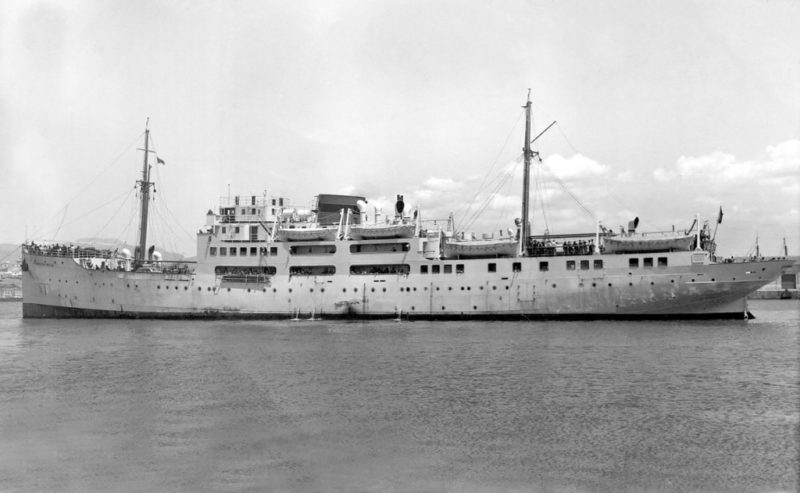
The Trasmediterranea ships that took the Nationalist side included the passenger and cargo ship A. Lazaro, sister of J. J. Sister, which was converted to a minelayer and auxiliary cruiser, and her sister V. Puchol which also became an auxiliary cruiser. Several other vessels became auxiliary cruisers for the Nationalists, including Mallorca, Infante D. Juan and Ciudad de Palma, and the Nationalist forces sank more Republican Trasmediterranea ships during the two year period from March 1937 to March 1939, including Ciudad de Barcelona, Isla de Menorca, Legazpi and Mahon. The Balearics islands were split in their allegiances, with Palma and Mallorca taking the Nationalist side, and Mahon and Menorca taking the Republican side. Mahon and Menorca finally surrendered to the Nationalists in early 1939, and this terrible war, which had seen the atrocities of aerial dive bombing by the German Stukas of the Condor Division of the Luftwaffe of the civilian population of the Basque town of Guernica, immortalised in the painting by Picasso, finally came to an end.
WORLD WAR II
The shattered Trasmediterranea fleet was gradually raised from the harbours of all of the Spanish ports and repaired and put back into service. The fleet was also augmented in 1939 by 37 cargo ships and one tanker seized by the Spanish Government in Spanish ports during the Civil War and given ‘Castillo’ names e.g. Castillo Simancas, built in 1907 as Den of Ruthven by Charles Connell on the Clyde, and transferred in 1942 to Empresa Nacional ‘Elcano’, the Spanish National Line. The last company steamer, Plus Ultra of 4,312 grt and completed in May 1928 by the Union Navale de Levante yard at Valencia, served on the Canaries route carrying general cargo and potatoes until eventually arriving for breaking up at San Esteban de Pravia near Aviles and Gijon on the north coast of Spain in June 1977. The sister steamers Isla de Tenerife and Isla de Gran Canaria of 5,120 grt built in 1921 at Bilbao by Compania Naval de Construcciones and purchased seven years later, lasted until the early 1970s. This had been greatly helped by Isla de Tenerife being laid up on the Tyne from October 1936 for the three years of the Spanish Civil War, with her sister safely moored in another North European port.
The log of J. J. Sister has survived in the Naval Military Archives in Barcelona, and she made many voyages from 1944 until near the end of 1947 from Barcelona to Genoa, including one in 1944 with Monsignor Escriva de Balaguer and his Catholic priests. She arrived at Barcelona from Genoa on 19th June 1946 with a group of Polish refugee children from Barletta that had embarked at Genoa. Two days later, she completed loading a cargo of bananas and other fruit at Barcelona destined for Switzerland, and with Monsignor Escriva de Balaguer and his Catholic priests onboard again, and all other passengers and mail onboard, she sailed at 1800 hours for Genoa. Later that evening, she began to roll in a heavy sea in the Gulf of Leon with a big storm whipping up the waves for the next 10 to 12 hours, smashing crockery and with furniture sliding around. The ship’s pumps could only just cope with the amount of seawater coming onboard, with the First Class Utility room flooded and Second Class cabins under water up to knee height. The rough seas lasted throughout 22nd June until 1100 hours on 23rd June when the entrance to the Port of Genoa was reached, six hours late. She continued on this run with four voyages from Barcelona to Genoa and one from Barcelona to Civitavecchia in 1947, until she sailed from Palma de Mallorca to Seville on 6th December 1947.
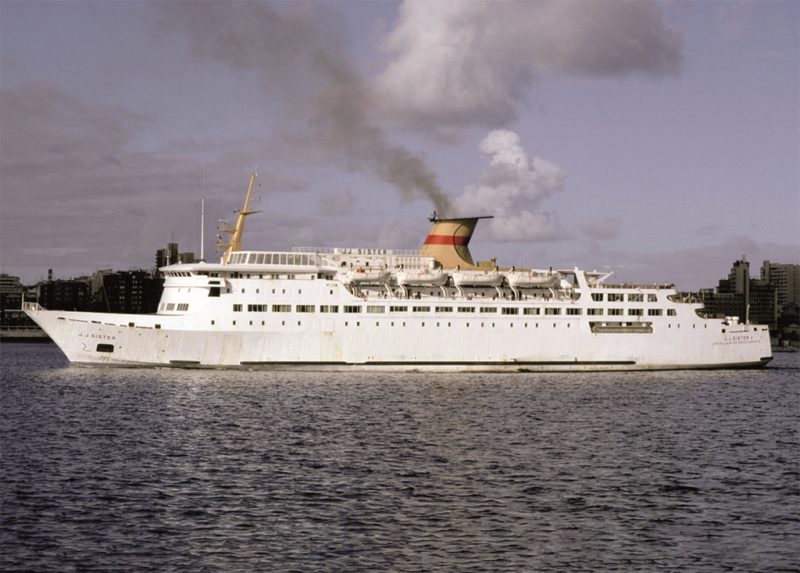

POST-WAR SERVICE
Although theoretically neutral during World War II, Franco had given great help and tacit approval to Fascist Germany, and thus in 1946 Spain was forced to rebuild her fleets using her own steel plants and shipyards as no other shipyards in the Western world would build them. The first unit of the rebuilding programme was an unlikely candidate in the wreck of the DFDS passenger motorship Esbjerg, one of a quartet of sisters used on the Harwich to Esbjerg route with sister Parkeston used on the Newcastle to Esbjerg route. Esbjerg had been mined and sunk off Stevns on 29th July 1945 and although raised was found not worthy of repair. Her shattered hull was sold to Trasmediterranea and towed to Valencia in August 1947 to be totally rebuilt. She was renamed Ciudad de Ibiza and served the Valencia to Ibiza route for the next thirty years. She was broken up at the end of 1978 at Villanueva y Geltru, and parts of her bow and stern were saved for public display at Museo Maritimo Roig Toiqs beside the fashionable resort of Sitges near Barcelona.
- J. Sister served on the Malaga to Melilla, Balearics routes, and made some isolated voyages to the Canary Islands in post-war years. In June 1950, she was assigned to the inter Canary Archipelago service, including day trips between Santa Cruz de Tenerife and Las Palmas de Gran Canaria, which due to her speed she made a daily return voyage, the first time in the history of Canarian communications that this was possible. She served during 1953 on the Alicante to Oran service on a weekly frequency. During the years 1956 to 1964, she served on Balearics routes as the reserve passenger ship used during the refits of her more modern fleet consorts. She was often laid up at the West Dock at Palma de Mallorca, and made several cargo only voyages during 1964 from Palma to Valencia before she was sold at public auction on 29th September 1964 to be broken up at Valencia, the port she had first arrived at in 1910.
The passenger and cargo vessel Ciudad de Alcira of 2,518 grt was completed in 1946 as Alcira, and was renamed in the following year. The twin screw Ciudad de Cadiz of 1951 and Ernesto Anastasio of 7,295 grt were two of a class of handy good looking passenger ferries built in Spain during 1948/54, their sisters going mostly to Trasatlantica. They had accommodation for 440 passengers and a good service speed of eighteen knots on the Barcelona to Malaga, Cadiz and Canaries route from twin B & W diesel engines of 7,000 bhp. Ciudad de Cadiz was broken up in 1979 and Ernesto Anastasio was wrecked on the Spanish coast on 24th April 1980 at Bancha del Oeste, Pasajes with the wreck refloated and broken up at Santander in July 1980. Two of the Trasatlantica sisters were purchased by Trasmediterranea in 1973, although only one entered service as Isla de Formentera, the other being destroyed by fire as Isla de Cabrera during a refit.
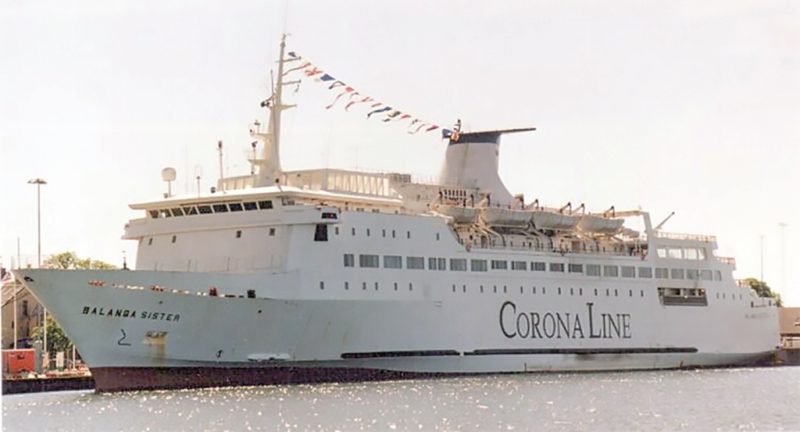
Four good looking passenger ferries were delivered during 1955/61 by the Valencia yard of Union Navale de Levante as Ciudad de Barcelona, Ciudad de Burgos, Ciudad de Granada and the smaller Ciudad de Tarifa. They were used on the nightly Balearics, and Algeciras to Tangiers routes, and had accommodation for between 400 and 900 passengers. Ciudad de Toledo from the Euskalduna yard at Bilbao in 1956 was a cargo-liner with good cargo capacity and accommodation for 54 passengers, which became a floating exhibition of Spanish industry and visited 31 ports in sixteen different countries between August and December 1956. Villa de Bilbao and Ciudad de Pamplona built in 1962/64 were enlarged versions of the four hold cargo ship Ciudad de Oviedo of 1957. Four smaller passenger ferries were the sisters Virgen de Africa and Victoria on the Algeciras to Ceuta service, and the sisters Ciudad de Teruel and Ciudad de Huesca on inter Canaries services.
A ferry had been converted into a side loader ferry in 1951 for the Algeciras to Ceuta route, but the first new car ferries were the ‘Albatros’ class of four side loaders completed in 1966/67. Juan March, named after a company manager from the island of Mallorca, Ciudad de Compostela, and the Canaries ferries Las Palmas de Gran Canaria and Santa Cruz de Tenerife carried 750 passengers on the Barcelona to Palma, Cadiz and Canaries route. Juan March was sold in 1985 and became the cruise ship Ocean Majesty, and Ciudad de Compostela was the last of the class to be sold in 1992, going to Greek owners and sinking after a fire on a Piraeus to Venice voyage in June 1994. Two twin funnelled engines aft sisters were completed in 1969 at Valencia as Antonio Lazaro (2) and Vicente Puchol (2) with accommodation for 600 passengers with service speeds of seventeen knots on the Malaga to Melilla route and later on Balearics routes from Valencia and Alicante.
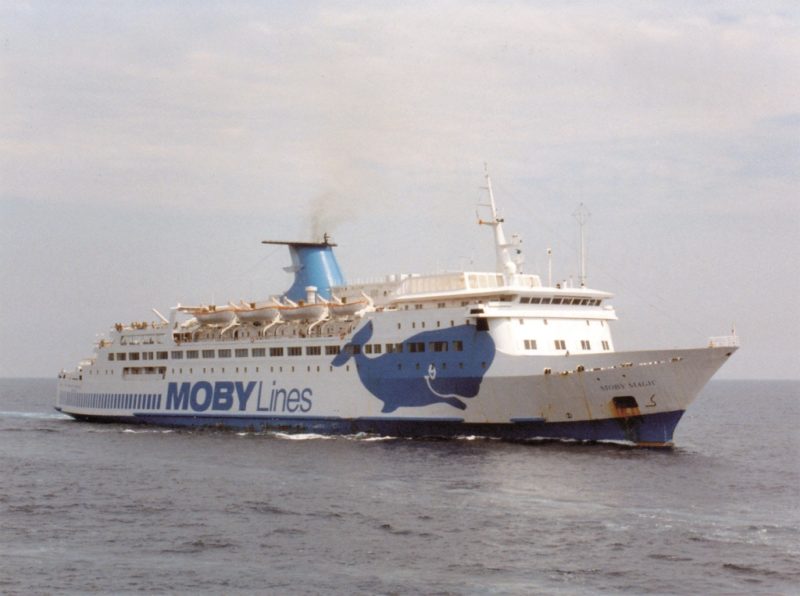
1.J. SISTER (2) OF 1975
Two larger exact sisters of the ‘Tiburon’ class were ordered from the Valencia yard of the Union Naval de Levante on 20th September 1971 as J. J. Sister (2) and Manuel Soto with accommodation for 712 berthed passengers in 169 cabins, and 368 deck passengers. They had unusual tops to their yellow and red funnels with a yellow navigation mast on top of the forward Observation Lounge, eight lifeboats on Boat Deck with two passenger decks below this deck and the Sun Deck above. The wheelhouse had nine large windows looking forward, which were equipped with clear-view screens by George Kent Ltd. of Luton. The passengers were graded into Preferred (First) and Economy (Second) clases.
- J. Sister (2) was launched on 18th May 1974 by Mrs. Carmen Polo de Franco, wife of the Head of State, and completed on 13th September 1975 after she had achieved trials speeds of 25 knots. They were sold at the end of their Trasmediterranea careers to Moby Line of Italy and renamed Moby Magic and Moby Fantasy respectively. A change in livery took place in 1980 on the nationalisation of the fleet, with light green and blue stripes swept back at rakish angles from bridge to stern and ‘Trasmediterranea’ painted along their white hulls. The streamlined light green and blue funnel colours carried the new ‘TF’ company logo.
- J. Sister (2) arrived in Palma de Mallorca on 15th September 1975 under the command of Capt. Salvador Ventura Moreno to make eight return voyages on the Barcelona route on a trial basis before she entered Trasmediterranea service on 2nd October 1975 on the Barcelona to Malaga, Cadiz and Santa Cruz de Tenerife, Las Palmas de Gran Canaria, Arrecife and Las Palmas route, taking an average of 31 hours to reach the archipelago at a speed of 22 knots or 85% of full power. She also served on the Genoa to Canaries route from November 1985 to May 1986 when the route was abandoned.
- J. Sister (2) was of 9,120 grt on dimensions of overall length 140.82 metres, moulded beam of 22.51 metres, moulded depth of 13.21 metres and loaded draft of 6.42 metres. She had a completely welded hull with two decks for passengers and the car deck clear of the machinery spaces of height 4.1 metres and of 250 car capacity with access via a stern ramp and door. She had a service speed of 22 knots from four 12 cylinder four stroke single acting M.A.N. diesel engines of total power of 26,800 bhp built by Empresa Bazan de Cartagena, and driving twin controllable pitch screws via clutches, flexible couplings and single reduction gearing. She had five auxiliary generators each of 600 kilowatts capacity for electric lighting, two thrusters for manoeuvring in port, and carried bunkers of 1,161 tonnes of heavy fuel oil and 118 tonnes of diesel oil, and water ballast capacity of 1,008 tonnes.
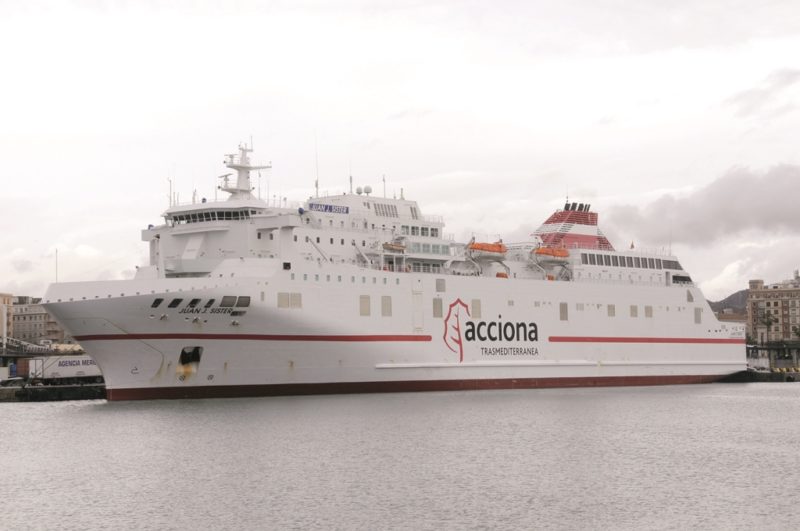
A tight schedule allowed only short times in port for the sisters after reversing into the terminals at their four ports of call, two in Spain and two in the Canaries, with the Barcelona call later dropped in favour of Cadiz. In December 1981, she answered a distress call of the fishing boat Nuria sinking south of Casablanca and rescued her crew. In 1985, she began the first of a series of six summer cruises to the Caribbean to commemorate the 500th Anniversary of the four voyages of exploration of Cristoforo Columbus (Colon).
The 1985 Caribbean cruise was entitled ‘Bound for Zipango (Cuba)’ from La Rabida near Cadiz to Santa Cruz de Tenerife, Las Palmas, the island of San Salvador in the Bahamas, Havana, Puerto Plata and Santo Domingo in the Dominican Republic, for which she was temporarily renamed Guanahani after the original inhabitants of the island of San Salvador island in the Bahamas. Zipango was the name given by Marco Polo to Japan, and Colon thought that he might have reached Japan instead of Cuba. The 1988 Caribbean cruise of 28 days was entitled ‘Heading to the Antilles’ and sailed from Spain to the Bahamas, Cuba, Dominican Republic, Puerto Rico and Portugal. The 1989 Caribbean cruise of 33 days was entitled ‘Heading for the Orinoco Jungles’ and sailed from Spain to the Cape Verde Islands, Venezuela, Dominican Republic and Portugal. The 1990 Caribbean cruise of 39 days was entitled ‘Heading to the Mayan World’ and sailed from Spain to Mexico, Costa Rica, Panama, Colombia and Puerto Rico. The 1991 Caribbean cruise of 42 days was entitled ‘Bound for Amazonas’ and sailed from Spain to the Dominican Republic, Venezuela and Brazil. The sixth and last Caribbean cruise in 1993 of 30 days was entitled ‘Expedition to the Hibueras (Honduras)’ and sailed from La Coruna in Spain to Vigo, Lisbon, Pointe a Pitre (Guadeloupe), San Juan de Puerto Rico, Santo Domingo, Guanaha (Bahia Islands in Honduras), Puerto Cortes and return to Portugal. The cruises were organised by the Ibero-American Studies with the sponsorship of the Confederation of Savings Banks, and with a classroom converted from a lounge for the students to study the adventure of the discovery of America, teaching from Spanish University professors and with a library of 4,000 books shipped onboard, the students quickly grasped the importance of the discovery of the Americas.
In December 1990, she was chartered for a single voyage by the French Ministry of Defence for a voyage from Toulon to Yanbu al Bahr in the Red Sea to transport French troops and tanks to the war conflict with Iraq. At the end of her last Caribbean cruise in 1993, J. J. Sister was transferred to the ownership of Agencia Schembri S.A., a company owned by Trasmediterranea to make her available for cruise charter work. During 1994, J. J. Sister (2) was chartered to Corona Line A/B for Baltic service between Gdynia in Poland and Karlskrona in Sweden as Balanga Sister. At the end of 1994, she was laid up or short term chartered out to Topas Line in September 1995 for a service between Brindisi and Ancona under her original name. She was sold to Moby Lines of Italy and renamed Moby Magic with a blue whale painted on her white hull on 23rd February 1997. She was later flooded in her engine room on 11th September 2003 while sailing from Livorno to Olbia when she hit a submerged object three miles from Olbia, with the passengers and crew evacuated and the ship towed to Golfo Aranci to carry out emergency repairs.
Manuel Soto had been sold in April 1991 to Navigazione Arcipelago Maddele-nino and renamed Moby Fantasy for the Bastia in North Corsica route to Genoa and Livorno. She was registered under Moby Lines in 1994 at Funchal on Madeira and remeasured at 12,888 grt, and was later switched to the Olbia in Sardinia to Livorno route to run alongside her sister Moby Magic, which was sold for breaking up at Aliaga in Turkey in December 2005. There is a model of J. J. Sister (2) in the Maritime Museum in Barcelona.
JUAN J. SISTER OF 1993
The flagship passenger ferry Juan J. Sister of 22,409 grt with accommodation for 550 passengers and 150 cars was completed in May 1993 by Kvaerner Masa yards at Turku in Finland for the Cadiz to Canaries service, but was later switched to operate on the Almeria and Malaga to Melilla route from 2014. She has dimensions of overall length 152.0 metres, moulded beam of 26.0 metres and loaded draft of 6.0 metres, with 142 cabins for 406 berthed passengers in two, three or four berth cabins, and 150 unberthed passengers. A locked baggage room is provided for unberthed passengers, and for berthed passengers all cabins have towels, bed linen and toiletries. She has two stern ramps and doors and one bow ramp and door for a faster loading and unloading process, and her car deck has space for 150 cars and 92 trailers on 1,680 lane metres with a clear height of 4.5 metres. She has a service speed of 18 knots from four 8 cylinder four stroke Wartsila diesel engines of total power of 14,684 bhp. Four generators of 1,065 kilowatt power supply electricity throughout the ferry, and she has bunkers for 526 tonnes of oil, and is equipped with two forward thrusters for port arrivals and departures.
Juan J. Sister has a Main a la carte Restaurant serving a Mediterranean menu offering Iberian ham, fresh salads, crawfish croquettes, meat, seafood, rice paella, spaghetti bolognese, mashed potato, hamburgers, French fries, good Spanish wines and several desserts to follow. Typical Moroccan food prepared with halal products e.g. vegetable tagines, lamb, chicken and fish are also offered, and the self service Buffet offers hot and cold dishes, salads, paella rice dishes, pasta, tapas, omelettes, soups, stews, meat and seafood, all taken with hot or cold drinks, beers and wines. There is a separate menu for children as well as healthy vegetarian options. A self service café sells coffee and patisseries e.g. cakes, sandwiches, pastries, pizzas, paninis, light snacks, chocolates, ice cream, fruit juices, liqueurs and other hot and cold drinks.
The ship’s duty free shops sell perfume, cosmetics, leather goods, games, toys, colouring books, confectionery, clothing, fashion accessories, cameras, sunglasses, jewellery, travel essentials, gifts, souvenirs, spirits, wines, tobacco and other alcoholic drinks. The children’s play area is supervised by ship’s staff and allows ball games, a paddling pool, and childcare services, with themed activities and group games, art and crafts, a Pirate day, mini disco with clowns and group parties in the peak Summer season. There is a Solarium on Sun Deck for relaxation on sun loungers, jogging track, swimming pool, jacuzzi, outdoor bar terrace, and an air conditioned room for pets with kennels and cat rooms and pet walking areas. The Sun Deck also has the emergency helipad circle painted on the deck. There are also a Disco Bar serving a variety of drinks, a Video Games Room, free wi-fi, cash machines next to the information bureau, and two large capacity seating lounges, one for Economy Class and one for Club Class, with reclining aircraft type seats and television. The movement of passengers around her decks is very easy with several elevators provided and staircases to all public decks. Boat Deck has six lifeboats, four large boats and two inshore craft, with both Boat and Sun Deck having public facilities under the large funnel aft.
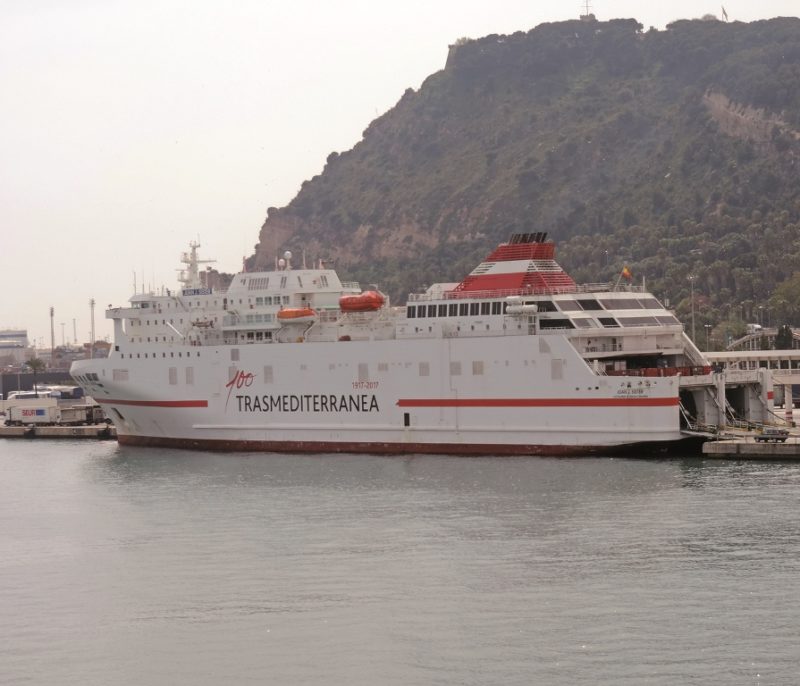
Trasmediterranea lost its monopoly in 1998 on the lines that linked Spain with her islands and the two enclaves in North Africa due to liberalisation of the sector. The fleet was privatised in July 2002 for €259 million by a consortium consisting of leading Spanish transportation, logistics and construction group Acciona Logistica (60%), Caja de Ahorros del Mediterraneo, Compania de Remolcadores Ibaizabal, Agrupacion Hotelera Doliga, Suministros Ibiza and Naviera Armas. Later that year, the company changed its name to Acciona Trasmediterranea operating from a headquarters in Madrid, and although it had lost its monopoly it was still the leading ferry company that linked the Spanish mainland with her islands and her two enclaves in Northern Africa.
The privatised Trasmediterranea company had a fleet of 26 ferries in 1998, and the frequency of these passenger services on conventional ferries was daily from Barcelona to Palma, six per week Barcelona to Ibiza, three per week Barcelona to Mahon, six per week Valencia to Palma, once a week Valencia to Ibiza and Valencia to Mahon, once a week Cadiz to the Canaries, and frequent daily services from Algeciras to Tangiers and jointly operated with Euroferrys, Comarit and Limadet Ferries. Fast ferries operated at forty knots at a frequency of six per day from Algeciras to Ceuta, and six per week from Barcelona to Palma, and frequently during the day linking Tenerife and Gran Canaria.
There was also a service from Los Cristianos in Southern Tenerife to San Sebastian on beautiful La Gomera and Valverde on Hierro. The ferry Isla de La Gomera had been purchased in 1998 from Limadet Ferries as Ibn Batouta 2 and initially served on the Algeciras to Tangiers route as Ciudad de Tanger, and was then transferred to the Canaries in 2002 and renamed. In 2004, ‘La Tras’ gave up its Los Cristianos in Southern Tenerife to Gomera and Hierro services, which were taken over by Naviera Armas S.A. using the former Baltic favourite Volcan de Tenagua. Freight services were operated between Algeciras and Ceuta by a company established in late 2002 as Maritima de Ceuta by Acciona Trasmediterranea, Euroferrys and Buquebus, with the ‘La Tras’ contribution being Ciudad de Algeciras built in 1980 as Bahia de Cadiz for Isnasa S.A., and the freight services from Cadiz to the Canaries were operated by three ‘Super Fast’ ro-ros.
The funnel colours of Acciona Trasmediterranea were red with a thin black top and a white central band, and hull colours are white for all passenger and freight ro-ros with a thin red line together with the company logo in black next to a red leaf logo. The fleet in 2007 consisted of twenty bright, modern and fast ferries on all of its premier island routes, including 48 knot Incat wave piercers with capacity for 900 passengers and 280 cars. Milenium and Milenium Dos operated a fast Barcelona to Palma service, with Milenium Tres on the Almeria and Malaga to Melilla route in Africa. In July 2006, Trasmediterranea took over rival ferry company Euroferrys on the Straits of Gibraltar routes after the sale was cleared by the Spanish authorities. A short lived service to Portsmouth from Bilbao in 2007 using the big passenger ferry Fortuny was under – utilised and soon withdrawn.
In April 2009, an EU subsidy of €30 million was awarded to ‘La Tras’ for a Vigo to St. Nazaire, Nantes and Le Havre freight link with four weekly sailings to help trucks bypass the congested Pyrenees road links. A new ro-ro cargo service had begun twelve months earlier between Barcelona and Tangiers to carry a significant portion of the Moroccan fruit and vegetable harvest on the return voyage on company freight ro-ros. The company freight routes to the Canaries from Barcelona and Algeciras on a trio of ‘Super Fast’ freight ro-ros were showing significant increases in cargo carried and profits. The company continued to look for new freight ro-ro routes, including to Italy in partnership with Grimaldi, and also to Algeria from the port of Almeria.
After Juan J. Sister was switched in 2014 to the Almeria and Malaga service to Melilla, a very serious fire occurred on 28th April 2015 on the chartered Grimaldi ferry Sorrento, completed in 2003 as Eurostar Valencia, when she was fifteen miles from Palma on Mallorca after a crossing from Valencia. She had 156 passengers and crew on board, and after the fire on her car deck flared up, they were rescued from lifeboats by passing ships with some airlifted off by helicopter, but unfortunately four crew members were badly injured. She had been chartered to Acciona during the previous year and the completely burnt out hull was eventually towed into Sagunto on 6th May after many ports had refused to allow her entry as she was in danger of sinking. Scandola was another chartered ro – pax built in 1993 in Holland and previously sailed under the names of Ionian Star and Via Ligure, and sailed for ‘La Tras’ on the Valencia to Ibiza route in 2015 with accommodation for 363 passengers and two hundred cars.
In 2017, a fleet of twenty ferries was being operated on regular Cadiz to Canaries, inter Canarian, Balearic, Northern Africa and Straits of Gibraltar services. Four fast ferries were owned, with Alboran, Alcantara Dos, Almudaina Dos and Milenium Dos operated on various routes, and four freight ro-ros in Jose Maria Entrecanales, Super Fast Baleares, Super Fast Galicia and Super Fast Levante, all with a lane length of 3,400 metres. There were a dozen large passenger and car ferries operated by Acciona, with the ‘super ferries’ of Sorolla and Fortuny of 26,912 grt as the flagships of the fleet. Juan J. Sister operated on the Almeria and Malaga to Melilla route, and the other passenger ferries in the fleet were Albayzin, Almariya, Ciudad de Malaga, Las Palmas de Gran Canaria, Tenacia, Forza, Adriatico, Vronskiy and Zurbaran. The company celebrated its centenary during 2017, with exhibitions of photographs of the passenger ships over the century, including J. J. Sister (1) and (2) and Juan J. Sister, and visits to the Madrid Head Office of the company by many Spanish dignatories. All twenty passenger ferries were repainted with a stylised red ‘100’ and ‘1917-2017’ above Trasmediterr-anea on both sides of their white hulls.
The green light was given by the Spanish competition authorities on 23rd May 2018 for the acquisition by the Naviera Armas Group to take full control of Trasmediterranea, the premier Spanish ferry operator, from the Acciona Group of Spain for $307.2 million with 92% of the share capital purchased. In 2020, the Trasmediterranea fleet is now part of the Naviera Armas Group, which began operations in Las Palmas de Gran Canaria on inter-island services in the 1950s. The big combined fleet of Naviera Armas and Trasmediterranea now comprises 40 ferries, with 24 passenger ferries, seven fast ferries, five freight ro-ros plus four passenger ferries under construction or on order. The combined company carries five million passengers per year, 1.5 million vehicles per year, and 7.8 million lane metres of ro-ro cargo per year. The company serves 38 destinations in Spain, Morocco, Portugal and Algeria with 100 sailings per day.
The combined passenger fleet of Trasmediterranea and Naviera Armas now comprises Juan J. Sister, Forza, Almariya, Las Palmas de Gran Canaria, Ciudad de Malaga, Ciudad de Palma, Ciudad de Cadiz, Ciudad de Granada (ex Sorolla), Ciudad de Mahon, Ciudad de Ibiza, Nura Nova, Tenacia, Vronskiy, Volcan del Teide, Volcan de Tinamar, Volcan de Tijarafe, Volcan de Tamadaba, Volcan de Taburiente, Volcan de Timanfaya, Volcan de Tamasite, Volcan de Tindaya on the Lanzarote to Fuerteventura route, Volcan de Tauce, Villa de Teror and Ciudad Autonoma Melilla (ex Fortuny), plus four passenger ferries on order.
A new passenger ferry is due for delivery from the Barreras yard in Vigo during 2021 of 39,721 grt with accommodation for 1,800 passengers and a car deck of 3,110 lane metres, with an option for two more sisters, although these may be delayed by the complete halt in ferry operations during part of 2020 due to the Covid-19 pandemic. A further ferry is on order from Factorias Vulcano with accommodation for 1,500 passengers and space for 450 vehicles on its car deck. Juan J. Sister, as with all the ferries in the combined fleet, has a thick red hull band together with a larger red ring containing ‘AR’ for Armas, as well as ‘Trasmediterr-anea’ in black, on both sides of her white hull, and a red funnel with a white central band bearing a combined logo. Juan J. Sister is one of the older big ferries in the combined Armas-Trasmediterranea fleet, but is still a very useful passenger ferry with very many years of service left in her.
I wish to sincerely thank the excellent Trasmediterranea Centennial Book published in 2017 and written by Juan Carlos Diaz Lorenzo, Francisco Font Betanzos and Laureano Garcia Fuente.




Comments
Sorry, comments are closed for this item